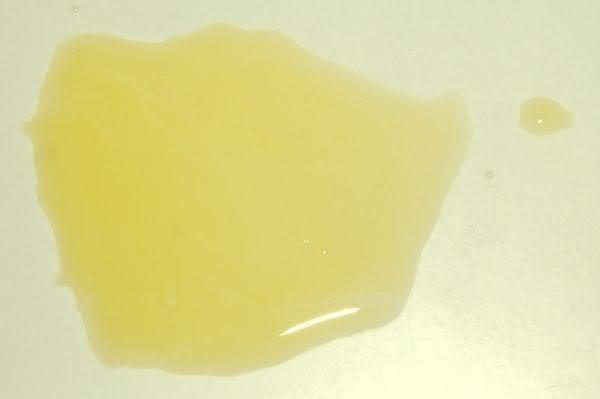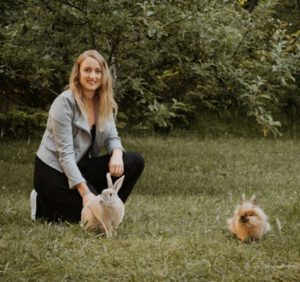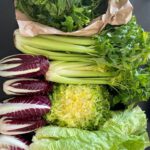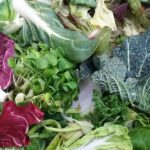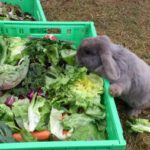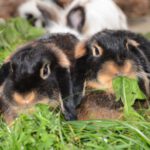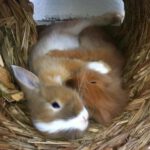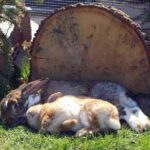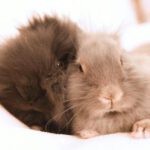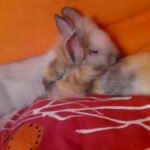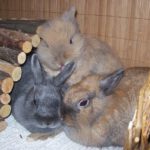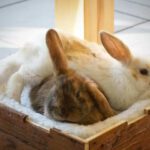Contents
- Hay Poop (fibrous, light-colored feces)
- Dark Poop (black, round, or teardrop-shaped poop)
- Hunger Poop (small, angular poop)
- Poop Chains (linked poop)
- Mushy Poop (soft, larger, misshapen poop)
- Diarrhea (liquid poop)
- Cecotropes/Soft Poop (shiny poop)
- Liquid or mushy cecotropes
- Worm Poop (Poop with White Stripes/Threads/Worms)
- White or Light Poop, Different Colored Poop
- Red Poop, Bloody Poop
- Gigantic, Large Poop & Poop Size
- Poop with Mucus Coating
- Mucous poops, mucous excretion (transparent or slightly discolored)
- White, Thick Discharge/Mucus, Mucus in Urine
- Poop with Undigested Parts
- Urinary sludge (gritty urine with a thickened consistency)
- Red, orange-brown, or black urine
- Normal urine with red streaks/drops/spots
- Slightly Cloudy Urine
- Very cloudy, milky, or white urine
- Mucus in Urine
- Clear, yellow urine
Hay Poop (fibrous, light-colored feces)
These poops are unusually large, very light in color, and you can still see individual hay fibers in them. They form when the diet contains a high amount of indigestible fibre. Many people mistakenly believe these poops are ideal and normal, and they may worry if their rabbit’s poops become darker and smaller, especially after a change in diet. However, ‚hay poops‘ actually indicate that the food lacks sufficient nutrients. A diet with such a high percentage of indigestible components is excessive, and these poops are not natural. It’s best to adjust the diet—rabbits producing these poops often consume too much hay and not enough fresh greens. ‚Hay poops‘ can also conceal digestive issues, as the extreme fiber content masks the true consistency of the poop.

Dark Poop (black, round, or teardrop-shaped poop)
Herb poop is the ideal type of rabbit poop. It is significantly smaller than hay poop, sometimes very small, but always soft (unlike constipated poop). Additionally, it is dark in color. Depending on the composition of their diet, the poop may vary slightly in color, shape, and texture. Typically, it is shaped like a raindrop or is round.
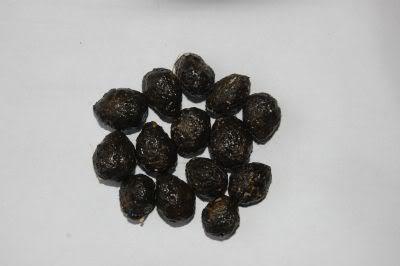
Hunger Poop (small, angular poop)
A reduced food intake leads to extremely small, angular, and hard poop. The poop is not round and soft, but very angular and stone-hard. This type of poop usually indicates a low food intake, which may require veterinary treatment and dietary adjustments (looking for the cause in the diet or needing therapy).
Mini poop can also occur with primarily dry food (such as dried herbs, seeds, etc.). The only exception is a diet primarily consisting of hay, as hay contains a high amount of fiber, which passes through the digestive system undigested and artificially increases the size of the poop. If mini poop results from dry food, the amount of fresh food in the diet should be significantly increased.
Another reason for mini poop can be low food intake due to feed shortages, unsuitable food, or other health issues (e.g., tumors, digestive disorders, pain, etc.). This can also occur immediately after anesthesia when the rabbit is not eating as before.
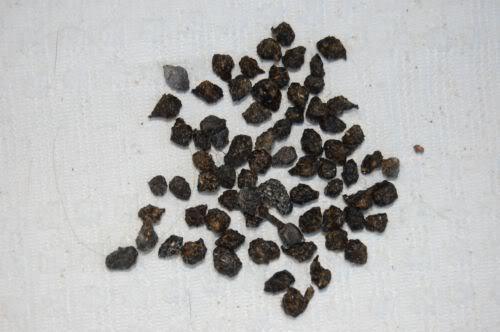
Poop Chains (linked poop)
If a rabbit in the group is shedding its fur, it can lead to poop chains. This can happen either when the rabbit grooms itself and ingests its own fur or when it is groomed by another rabbit, causing the other rabbit to ingest fur.
Poop chains form in the rectum, where the mass is shaped into poop. If this mass contains a lot of undigested fur, the individual pieces of poop can stick together. As long as the poop chains are being expelled, it is not a problem. However, if the fur remains in the intestines and causes a blockage, it is essential to seek veterinary care.

If a rabbit has poop chains, it’s important to keep a close eye on it to quickly notice if it refuses to eat or stops producing poop altogether.
Poop chains can also result from the ingestion of indigestible fibers (e.g., from carpets) or poorly chewed food (in animals with dental problems).
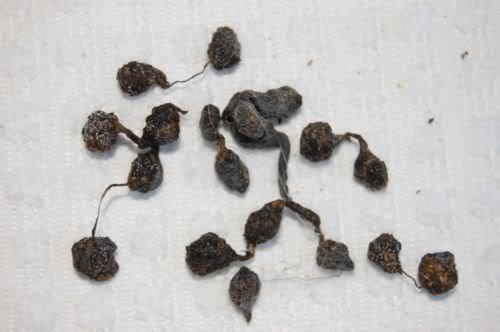
Mushy Poop (soft, larger, misshapen poop)
Mushy poop refers to poops that are too soft. This type of poop can occur due to unfamiliar food, poor-quality food, or an improper diet (such as too much root vegetables, fruit, dry food, and other sugar- and starch-rich feeds) and is a precursor to diarrhea. It’s important to identify what may have caused the issue (e.g., contaminated hay, greenhouse salad, etc.) and adjust the diet if it’s due to improper feeding. Additionally, a fecal sample from three days is advisable, especially if this issue occurs frequently. This can be submitted through the veterinary clinic or a laboratory. If mushy poop occurs only rarely or as an exception, it is not necessary to consult a veterinarian.

Mushy poop is often confused with cecotropes that have been crushed. Misshapen poop can be caused by its mushy consistency or by megacolon.
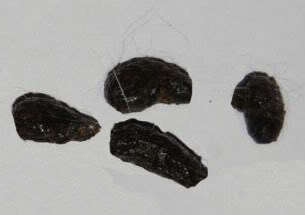
Diarrhea (liquid poop)
If the anal region is dirty or smeared with poop, or if you find watery poop in the bedding, often light brown, you can be sure that a rabbit has diarrhea.
There are many different causes of diarrhea (dental diseases, improper diet, unfamiliar food, infections, parasites, poisoning, organ diseases, etc.), and a veterinarian should always be consulted. Untreated diarrhea can be fatal (e.g., due to dehydration).
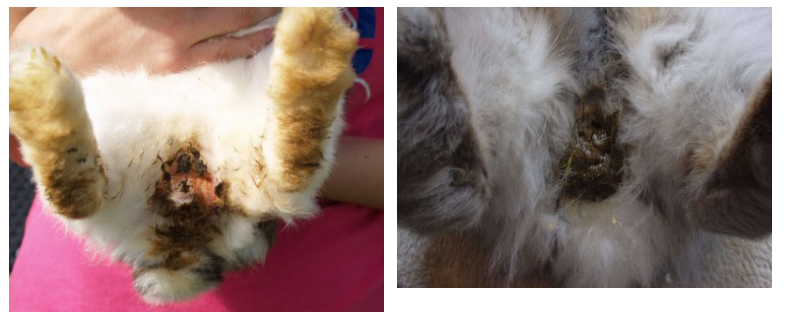
After successful treatment and cleaning (for fresh diarrhea: baby wipes; for crusted diarrhea: soak the rear in a bowl of water), the genital areas should definitely be cleaned, as they are located on either side of the genitalia and can become dirty when the poop is too soft (mushy poop or diarrhea).
However, smeared cecotropes are often confused with diarrhea or mushy poop. Cecotropes can also stick to the rear or be found crushed in the bedding if not ingested. Cecotropes are darker, and when they are passed, healthy poop continues to be produced normally. In contrast, with diarrhea, no normal poop is produced anymore, and diarrhea is usually somewhat lighter in color.
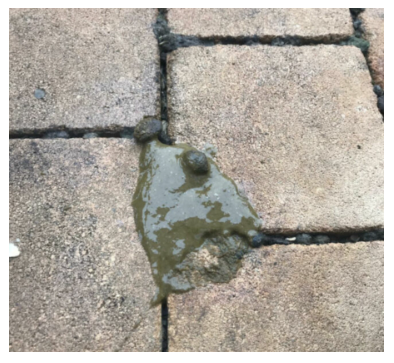
Cecotropes/Soft Poop (shiny poop)
Cecotropes are very dark (almost black), brown, or even olive green in some cases. They are soft, and linked together, resembling grapes.
In addition to normal hard poop, rabbits also produce cecotropes, which they often eat immediately (coprophagy—eating poop directly from the anus—is normal behavior). Cecotropes contain many vitamins, and when the rabbits eat them, they can be digested again. During the second pass through the digestive system, the vitamins can be absorbed in the small intestine, leading to better nutrient utilization and providing the rabbit with essential vitamins.
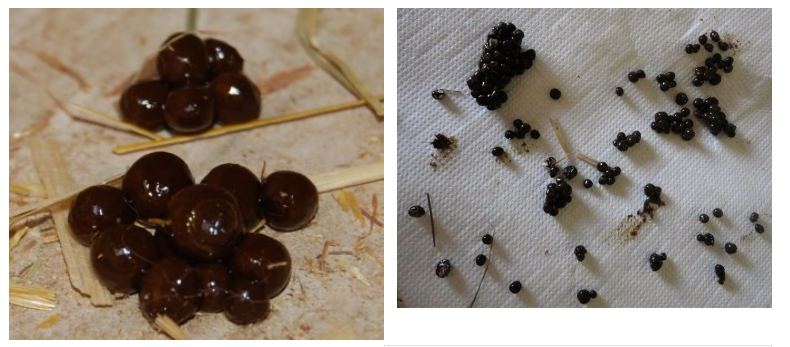
To protect the cecotropes, they are surrounded by a shiny mucous coating (mucin), which prevents absorption in the rest of the digestive tract before excretion. This gives them a very shiny appearance (as if oiled).
Some rabbits may hardly produce visible cecotropes because they are consumed immediately after being excreted. In others, smaller or larger amounts may be left behind. This is not a cause for concern, as only rabbits whose diet lacks sufficient energy content will consume all their cecotropes. Cecotropes often appear (temporarily) during dietary transitions to a more species-appropriate or protein-rich diet (e.g., to meadow greens). However, their presence is not always an indicator of illness, contrary to widespread belief.
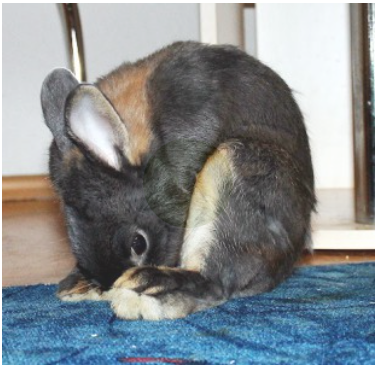
Diarrhea or Cecotropes?
Cecotropes can be easily distinguished from diarrhea or mushy poop by their color, shine, and shape (linked together, resembling grapes). Unlike diarrhea, there are no stains in the anal region when cecotropes are passed, unless the rabbit sits in the cecotropes. This could be due to several reasons:
– Obesity (the rabbit cannot reach its anus to consume the cecotropes)
– Pain when stretching back (joint issues?)
– Poor-tasting cecotropes (due to medications) or
– Excessive cecotropes (diet).

If a rabbit has „diarrhea“ on its rear overnight but produces normal hard poop in between, it is actually cecotropes!

Is there too much cecotropes being excreted?
In cases of extreme amounts of leftover cecotropes, there can indeed be pathological or exacerbating causes that must be investigated:
- Coccidia and worms: Especially in cases of coccidia and worm infestations, there can be excessive amounts of leftover cecotropes. A fecal sample can clarify whether an infestation is present.
- Dry food: Often, feeding rabbit dry food can lead to leftover cecotropes. It’s essential to learn about a species-appropriate, dry-food-free diet.
- Excess energy/nutrients (overly rich feeding)
- Too crumbly food: (e.g., pellets or dry food components that have been ground and then pressed or baked together, sometimes including certain hay types like Black Forest hay in individual rabbits).
- Diet changes and fluctuations: (e.g., feeding hay during the day and a lot of fresh food or dry food at night—starting with low energy and then suddenly switching to extremely high energy).
- Medications or other reasons that cause the cecotropes to taste strange.
- Feeding dry herbs: Especially during transitions or if the dry herbs are very fine or crumbly.
Additionally, conditions such as arthritis or other diseases may prevent rabbits from reaching for their cecotropes (due to associated pain or limited movement).
- Obesity: This can prevent them from reaching their cecotropes.
Liquid or mushy cecotropes
If your rabbit is passing liquid or mushy cecotropes, it is usually a sign of cecal inflammation. The cause is often dysentery due to an underlying condition, such as parasites (coccidia, worms), spoiled or unsuitable food, generally poor feeding (e.g., dry food), or severe stress. Yeast or bacteria can also be the cause.
In cases of dysentery, treatment typically involves Enrofloxacin (Orniflox, Baytril). Depending on urgency, a bacterial fecal sample may be examined first to determine which antibiotics will be effective. Additionally, parasites should be ruled out or treated through a fecal sample. Collect poop for three days and submit it to the veterinarian’s office or a laboratory.

For diet, meadow grass is ideal, or alternatively, leafy greens with no more than 10% herbs, no dry herbs, low-energy hay with few herbs, bitter greens, minimal cabbage, no fruit, and occasional root vegetables given by hand as treats. If the diet is very good and the fecal sample shows no parasites, bacteria are usually the cause. If the antibiotic helps only to a limited extent or if the problem recurs after stopping the medication, an ultrasound is advisable, as other issues, such as intestinal tumors or inflammation from impacted hairballs, may be involved.

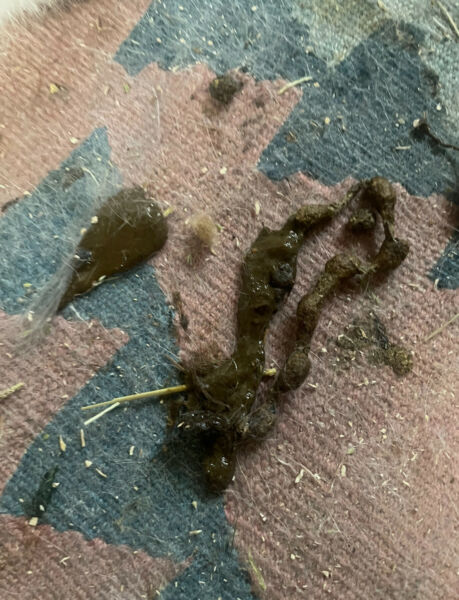
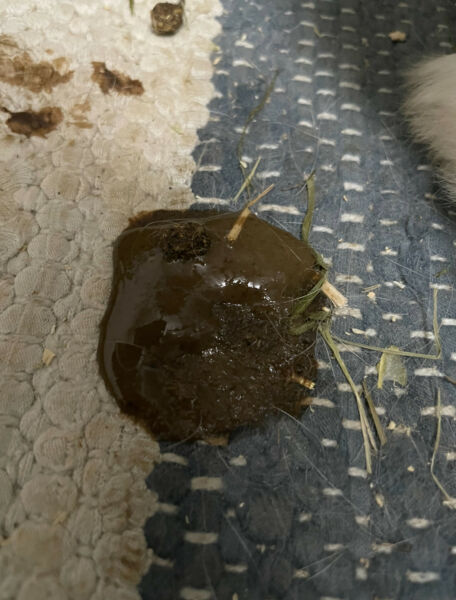
Worm Poop (Poop with White Stripes/Threads/Worms)
If a rabbit is infested with worms, you may occasionally see the worms (usually Passalurus ambiguus) in the poop. They can sometimes be alive, but they may also be passed out dead. Often, they are perceived as white stripes or threads. Not every infestation is visible in the poop. Worms must be treated by a veterinarian. Collect the poop in a bag and show it at the veterinary clinic.
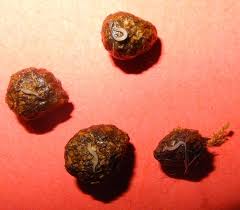
Excretion of dead worms during treatment:
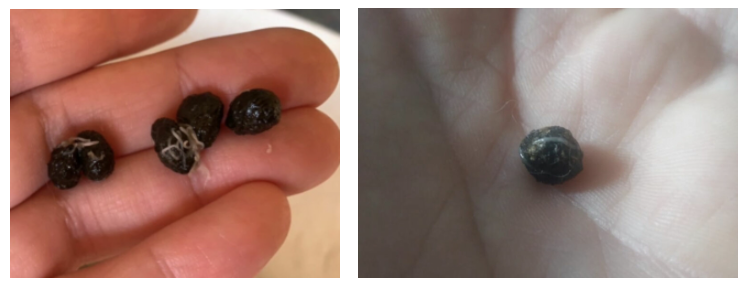
Tapeworm Infestation in Rabbits Before Treatment and the Worms Passed After Treatment:
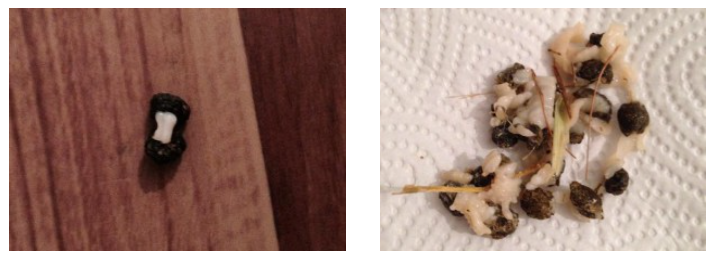
White or Light Poop, Different Colored Poop
Normal rabbit poop is usually dark (brown to black), while hay poop can be light brown depending on the type of hay. However, if you find light or even white poop in the enclosure, it is generally not a cause for concern. The poop can become light due to the diet, such as from feeding Dari seeds, and it may even be completely white.
White deposits (sedimentary deposits) on the poop occur when urine flows over the poop and then dries. The urine contains calcium, which can deposit on the poop and may be perceived as white after drying.

Red Poop, Bloody Poop
If there are bleeding issues in the posterior sections of the intestine, the poop can turn red as blood deposits on it.
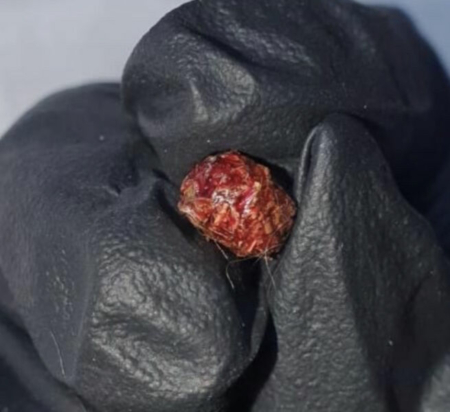
Consult a veterinarian!

Gigantic, Large Poop & Poop Size
The size of poop varies from rabbit to rabbit (larger rabbits have bigger poop than dwarf rabbits, and young rabbits tend to produce smaller poop). Additionally, the size can fluctuate due to other factors: When rabbits suddenly eat a lot or are in a molt, they often produce larger poop. Additionally, rabbits with conditions like Megacolon may produce larger, more misshapen poop.
After a blockage is resolved, a large poop plug may appear. If the poop is not firm or shaped but rather mushy, see ‚Mushy Poop.
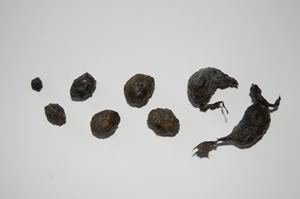
Poop from Rabbits with Megacolon Syndrome
Very large poop (for the size of the rabbit), which is often slightly misshapen, can be typical for a rabbit with Megacolon. Additionally, these rabbits can quickly experience diarrhea or other digestive disorders.
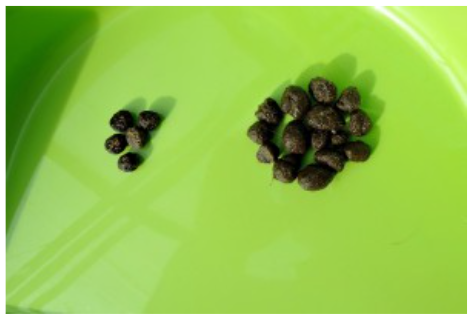
Megacolon Poop
Left: Normal poop, Center: Large poop, Right: Misshapen mushy poop.
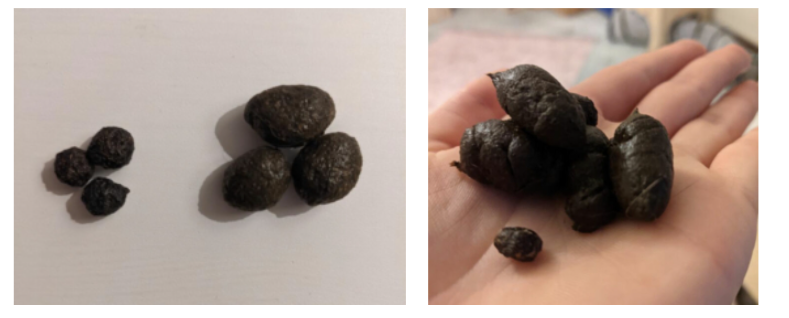
Poop with Mucus Coating
This type of poop is often the first to be passed after an intestinal blockage or digestive stasis. It should not be confused with cecotropes, which have a shiny coating.
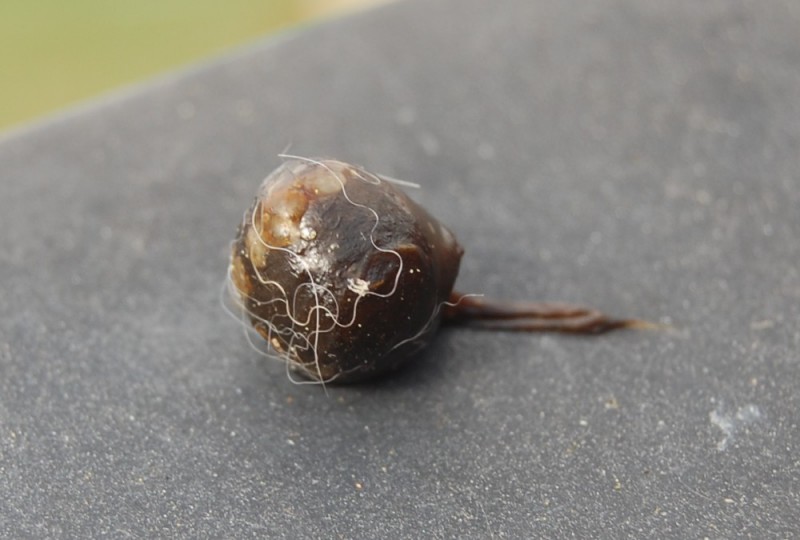
Mucous poops, mucous excretion (transparent or slightly discolored)
This condition is caused by fibrin and results from a (chronic) inflammation of the intestinal lining or antibiotic use (enteritis), where the inflamed intestinal lining is shed and expelled as clear mucus from the rabbit.

Any intestinal disease can be the cause, such as coccidia, bacteria, yeast, hairballs, or underlying conditions like intestinal paralysis (often seen in spotted rabbits as a hereditary disease, accompanied by coccidia and yeast). In many cases, medications that harm the intestinal lining (e.g., Panacur) can also trigger inflammation.
Mucus in poop can also occur after an intestinal blockage.
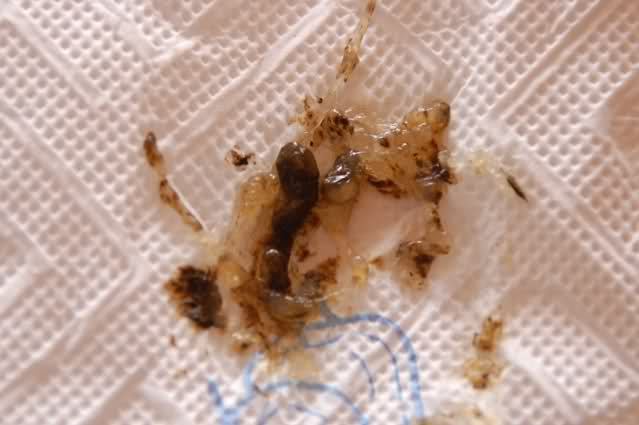
If clear mucus is found in the poop, the cause must be urgently determined by a veterinarian through a fecal sample and other potential tests. Collect poop for three days and send it to the vet or a lab for testing.

White, Thick Discharge/Mucus, Mucus in Urine
If you find white mucus in the enclosure, it could be from the vagina. Vaginal discharge in rabbits is a sign of illness and should be addressed by a veterinarian as soon as possible (uterine infection). It is often mixed with urine or poop.
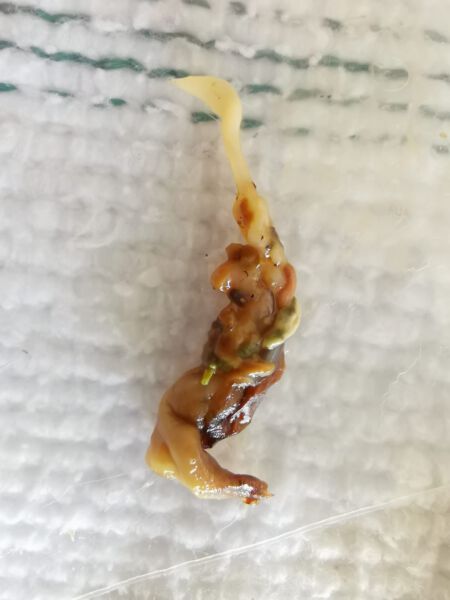
Mucus in urine may not only indicate a uterine infection but could also be excreted due to a bladder infection. Uterine mucus is sometimes passed with urine, making it hard to distinguish. However, uterine mucus is usually thicker than the mucus caused by bladder infections, which is more mucus-like than urine but not as thick.
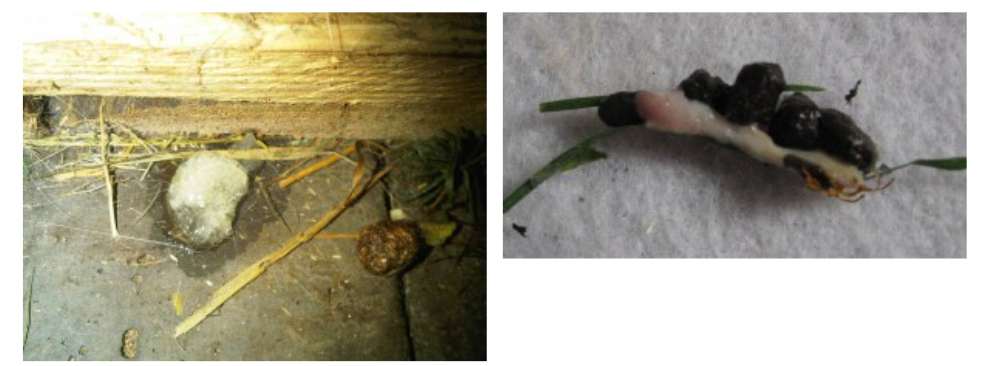
Poop with Undigested Parts
Usually triggered by gulping (or by dental problems or unsuitable food components), certain parts of the food are not chewed properly. As a result, they cannot always be digested in the intestines and appear undigested in the poop (similar to hay fibers). The best way to address this problem is to stop feeding these components and/or to combat the gulping. If dental problems are the cause, they must, of course, be treated. Large rabbit breeds, in particular, may chew roughly and swallow some particles without chewing them.
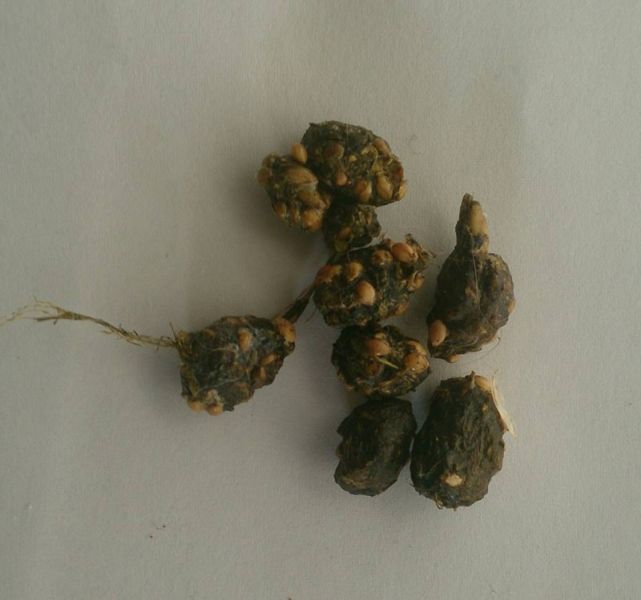

Urinary sludge (gritty urine with a thickened consistency)
Bladder sludge (grit-like urine) not only occurs due to genetic predisposition but also from increased calcium intake and, primarily, low water consumption. As part of the treatment, alongside veterinary care, a diet rich in water should be introduced (unlimited fresh food!). See calcium for more details.

If the sludge is being excreted, that’s a good sign since the real issue arises when it remains in the bladder. However, when sludge is found in the urine, an X-ray should be done to check how much sludge is still in the bladder or urinary organs. Veterinary treatment (like infusions) is needed if there are deposits present.
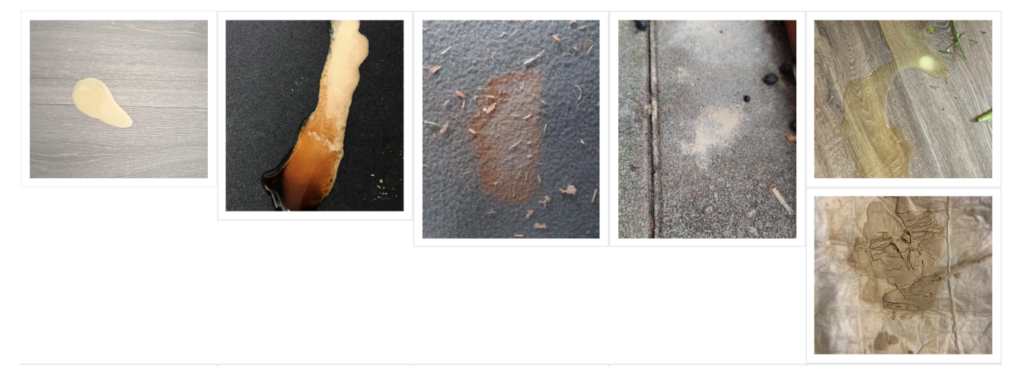
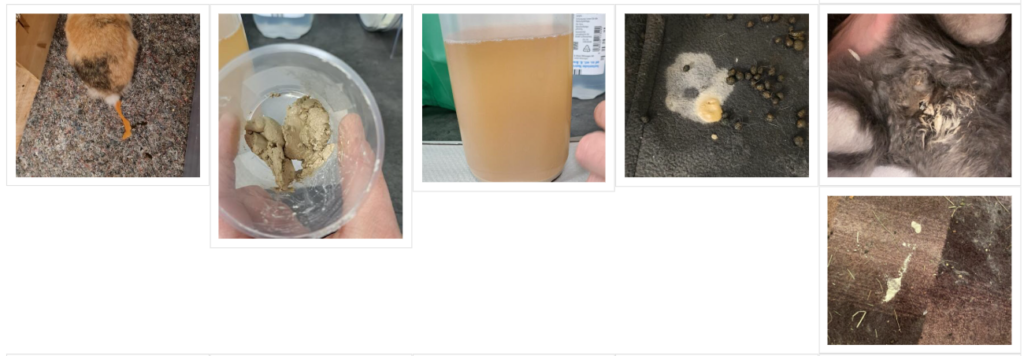
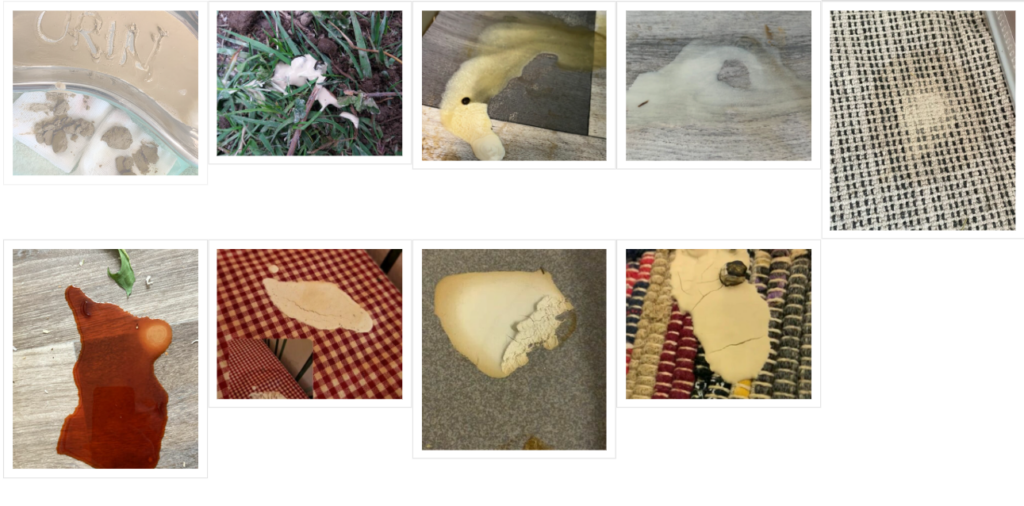
Red, orange-brown, or black urine
The urine can become red, orange-brown, or even black due to various feed ingredients, as the expelled food pigments impart these colors (the triggering food does not have to be red or colorful!). Many different feed types can cause these discolorations, and it’s impossible to list them all (e.g., dandelion, hazelnut, carrots (green), etc.). If urine remains in the bedding for a long time, it can also turn orange, reddish, or brown due to oxidation (contact with oxygen from the air).
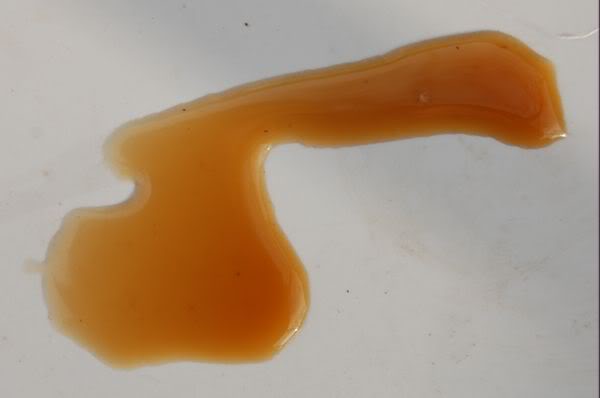
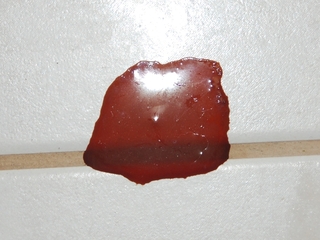
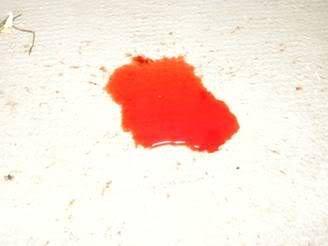
Medications can also cause urine to appear red. In stressful situations, some rabbits may react with red urine, including during socialization events. Additionally, reddish urine is often excreted for marking purposes, likely because it has a stronger odor. Pigments from endogenous breakdown (such as bile pigments, porphyrins, and melanin) can also lead to urine discoloration.
In general, it can be said that as long as the urine is uniformly colored, there is no reason for concern! It would be quite coincidental if blood were present (from food). If the urine were completely red due to blood, the rabbit would already be experiencing significant blood loss, as it would require a substantial amount of blood to cause such a change.
It’s also worth noting that rabbits do not have menstrual bleeding!
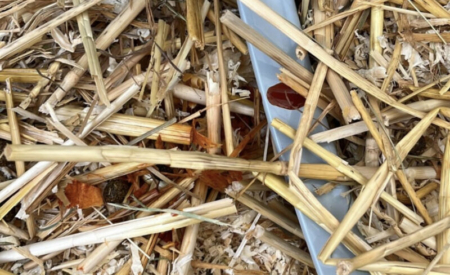
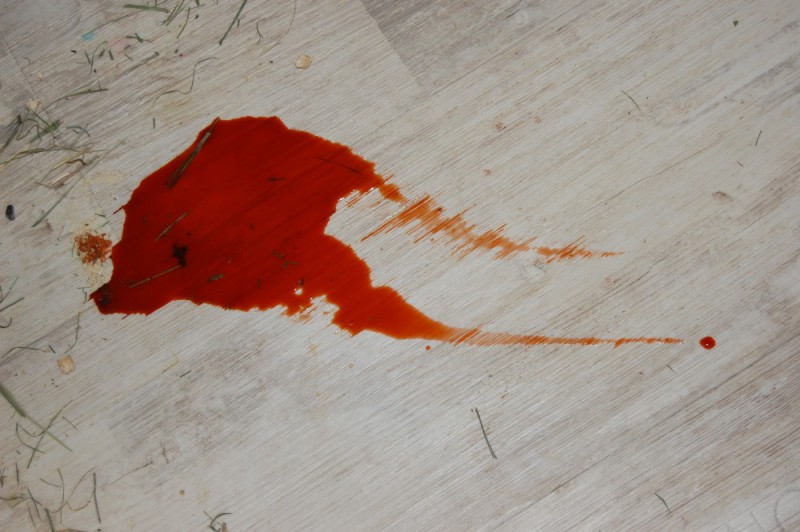
For those who are still unsure:
You can have the urine checked with test strips at the veterinarian’s office, or you can purchase them from a pharmacy, online, or from a home medical kit, for example, Combur 5 strips. A positive test for blood will show a positive result in the erythrocyte/blood field, and there may be additional indicators depending on the condition (for example, protein due to blood). The pH value in a healthy rabbit is typically between 8 and 9; refer to your home medical kit for interpretation!
To test the red urine, soak it up with a tissue and let it dry. If it turns a strong dark brown, it indicates the presence of blood. If it remains red, it could be blood or simply discolored urine.
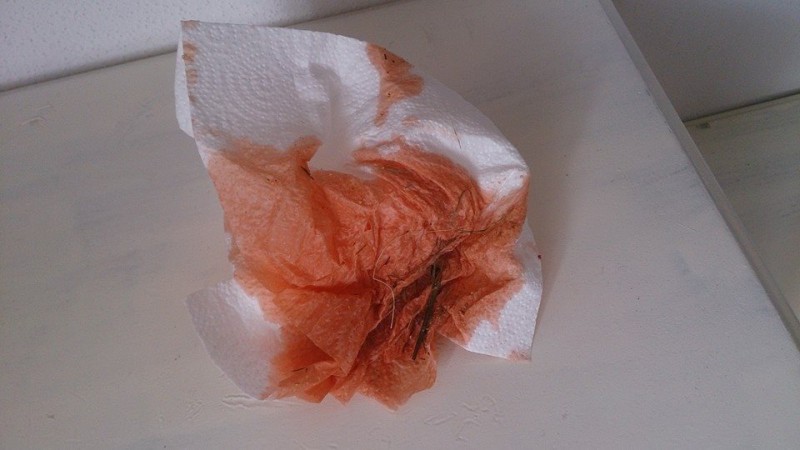
Normal urine with red streaks/drops/spots
If there is a red streak or a red drop in otherwise normally colored urine, it indicates the presence of blood! A veterinarian should be consulted as soon as possible, because if blood is visible this way, significant amounts are already being lost! Small amounts of blood may not be visible, and the urine will appear normal.
In cases of bladder infections or injuries in the urinary tract, the blood is usually mixed with the urine. In cases of uterine diseases, distinct drops of blood are often found in the urine.

Slightly Cloudy Urine
Normal rabbit urine from healthy animals is slightly cloudy.
When the urine dries, white deposits form on the surface, which is completely normal! Rabbits have a pronounced physiological crystalluria caused by their unique way of processing and excreting calcium, which is natural. The cloudiness arises from the excretion of calcium.

Very cloudy, milky, or white urine
If the urine is not just slightly but very cloudy, this usually indicates a diet low in fresh food with many dry components. To reduce the risk of kidney and bladder diseases, the amount of fresh food should be drastically increased.

Mucus in Urine
Mucus in urine has various causes; a small amount of mucus is normal. An increased mucus content indicates a urinary bladder infection (high leukocyte count, which can be checked with a test strip), an infection with mucoid E. coli strains, or a uterine disease.
Clear, yellow urine
Clear, yellow urine can result from high water intake, in which case it is completely harmless. The most common cause is a healthy, fresh food-rich diet; the high proportion of fresh food leads to significant water intake, which dilutes the urine and helps prevent urolithiasis (urinary stones).
However, it can also indicate calcium deficiency. This may be due to chronic kidney disease or a diet low in calcium, leading to a deficiency situation. Diabetes or other diseases can also result in clear urine, but in those cases, it is not completely clear. Young rabbits and pregnant or nursing (lactating) does may exhibit clear urine because calcium is fully utilized for bone development or milk production (increased demand). In these cases, the diet should be adjusted to include more calcium.
If clear urine is observed that is not associated with a fresh food-rich diet, please contact a veterinarian to discuss treatment options or dietary changes.
